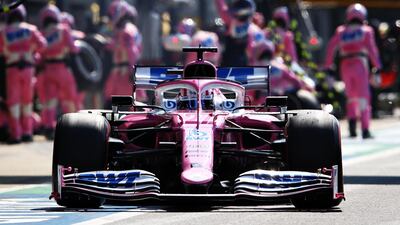Formula One has plunged into murky waters – a world of accusation, allegations of cheating, spying and recrimination – and it’s a crying shame.
Instead of celebrating an unexpected victory by Max Verstappen on Sunday, the sport is immersed in the Racing Point clone war.
Mercedes’ Andrew Shovlin admitted on Wednesday that their tyre issues in the heat at Silverstone cost them victory. ”It would be foolish not to think we will see it again or see it in Spain [on Sunday]. We need to look for solutions.”
Instead of rubbing our hands in glee at the faintest spark that, suddenly, the championship could yet be alive for an Abu Dhabi showdown, we have a complex copying row that threatens to wreck it all. And more besides, in a dispute most fans neither understand nor care about.
But it’s a row that cuts to the very heart of Formula 1, the nature of the competition: how the teams make their cars and how the hundreds of millions in prize money that is their life-blood is divided.
Unresolved it could change the face of the sport.
So let’s recap. Racing Point have judged to have used brake ducts designed by another team (Mercedes) and fined €400,000 (Dh1.73 million).
Back in the day, that was half the wheel-nut budget of a team like Ferrari. And consider a team like Racing Point, at the tail end of the front runners, will effectively spend around €6m per race weekend. Per car.
On January 1 2020 the brake ducts were put on the list of parts teams are required to make themselves to be considered a constructor.
But Racing Point protest they used ducts made before that rule came in and were exempt.
Far from resolving the situation the FIA’s judgement muddied the waters still further.
Despite ruling the ducts were indeed illegal they decided Racing Point could continue to use them.
Imagine the fury of teams being defeated by a copy car with parts publicly ruled illegal.
A copy car, moreover, that will now surely finish in podium places and deprive the rest of the extra points and the prize money that goes with it. That’s hundreds of millions potentially given those same cars, pretty much, are to be used next year.
Renault are particularly angry because they were disqualified last year in Japan for an illegal brake system and removed it. Who protested them? Racing Point.
Now it is the other way around. And they had been joined by Ferrari, Williams and McLaren only for the last two to withdraw on Wednesday.
It is, of course, entirely unconnected that Williams use Mercedes engines and McLaren switch to Mercs next season.
Brackley are so confident they are on the right side of the law they have challenged their rivals to take it to court. So Renault and Ferrari are have done just that.
___________________________________________________
Gallery: Max Verstappen wins at Silverstone
___________________________________________________
Maranello claim Racing Point’s actions are like “copying a test. There are those who copy the test and those who pass a test to have others copy it.”
But Mercedes compete in a world where Ferrari have strong links to Haas and Alfa Romeo and Red Bull own 100 per cent of AlphaTauri.
Both, though, have separate design teams but you have to wonder how much deeper the alliance goes when you recall Sauber (Alfa Romeo’s old guise) effectively telling Sergio Perez not to continue to chase the leading Ferrari for the win at the Malaysian GP in 2012.
Spying and copying is not new to F1. I have spoken to people responsible for eavesdropping on rival’s radio messages and found a detective agency employed by one team to follow another.
Mercedes claimed a photographer with a special 3D camera was stationed outside their pit earlier this season.
Renault’s stance is clear. Team principal Cyril Abiteboul said: “We’re not against customer teams but we are against customer cars.”
And the sport goes down that road at their peril. Imagine Mercedes supplying two ‘B’ teams, regularly taking the lion’s share of the revenue and eventually killing off the smaller operations and leaving a diminished 10 car grid.
And then there is Mercedes’ position: in any sport the supplier of an illegal performance-enhancing product would, arguably, face the most dire consequences of all.
If these brake ducts weren’t performance-enhancing there would not be much point in them being on the car.
When everyone is sploshes around in the sporting grey areas, the sludge, looking for an advantage the first casualty is usually integrity.
Whoever wins and whoever loses it will leave a nasty taste in everyone’s mouth.
F1 has always had one rule for the rich and another for the richer. The question is: which is which?











